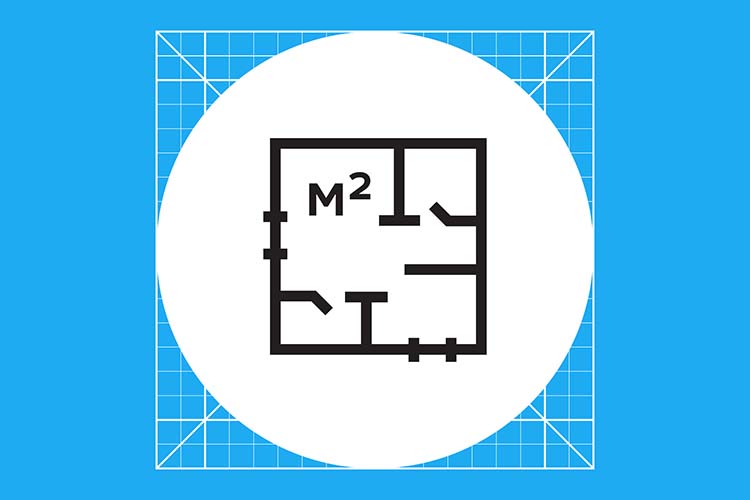

Another day doing math, and another day trying to solve formulae and calculate stuff. Among all the head-ache-inducing formulae that you may come across in maths, square meters stand at the very top of the list. We have created a small step-by-step guide to help you understand the method to calculate square meters.
But before we dive straight into how to calculate square meter and the square meter formula you need to use, you need to understand what is a square meter:
Related Read: https://ksa.mytutorsource.com/blog/a-beginners-guide-to-writing-numbers-in-words/
A square meter can be defined as the area equivalent to a square that is 1 meter on each of its four sides. Square meters are used to measure the areas of houses, blocks of land, rooms, etc. In other words, square meters are a measurement of an area and are typically used to measure a 2-D space like a floor or a field. The symbol used for square meters is m2.
For instance, you can use square meters to calculate the footprint of a sofa you saw at IKEA on your way home, and then measure your lounge’s area in square meters to see if the sofa will fit in or not. You do not need any special tools to measure square meters, even if you have a measuring tape or a standard ruler that measures in feet or some other non-metric unit, you can still measure the area with it, and then convert the answer to square meters.
First of all, you are going to need some appropriate equipment. Choose a metric tape measure or a meter stick. When looking to buy a tool, go for a tape measure or a meter stick ruler with centimeters (cm) or meters (m) printed on it. Using these tools can make it easier for a beginner to calculate square meters because they are also designed in a similar system of measurement.
But if you cannot find the said equipment and you only have a ruler with inches (in) or feet (ft) printed on it, use that to measure the square meters. You can then later convert your calculations to square meters. Now, start measuring:
Now, it is time for the conversions:
Convert into meters from centimeters and remember that your measurements will not evenly divide into meters. So, you will get a measurement in meters and centimeters, for instance, 2 meters 35 centimeters.
Now,
1 centimeter = 0.01 meters
So, you can convert centimeters into meters by moving the decimal point to the left by 2 digits.
Let’s convert 2 meters 35 centimeters to just meters:
Then multiply the length by the width after you have converted them both into meters. The result of multiplications will be your measurement of the area of your object in square meters. You can use a calculator if you like.
Let’s use our above measurements;
2.35m x 1.08m = 2.538 m2 (square meters)
You can round it off to the nearest number for your convenience. Thus, 2.538 square meters will become 2.54 square meters when rounded off. In fact, owing to human error, you most probably didn’t measure the sides of the object, to the tiniest fraction of a meter, correctly, so your last digits aren’t approximate anyway. Hence, you can just round off to the nearest centimeter (0.01m).
Keep in mind that when you multiply two numbers with the same SI units, your answer will always have the squared form of that unit. For example, meters will turn into square meters or m2.
Here is how you can convert into square meters if you are working with different units:
If your measurements are in square feet and you want to convert square feet to square meter, then you need to multiply the former by 0.093. Measure the length and width, with the equipment at hand, in feet and multiply them together to get the area of the object in square feet.
Since,
1 square foot = 0.093 square meters
You will have to multiply your answer by 0.093 to convert it to square meters. For a more precise conversion, multiply by 0.092903.
If your measurements are in square yards, then you will have to multiply them by 0.84 to get your answer in square meters.
For measurements that are in acres, you will have to multiply them by 4050 because:
One acre = 4050 square meters.
If you want to achieve greater precision in your answer, then multiply by 4046.9.
First, convert square miles to square kilometers because 1 square mile is way too large than 1 square meter. To convert square miles into square kilometers, multiply the former by 2.6 or you can multiply by 2.59 for more precision.
And then to convert to square meters use:
1 square kilometer = 1,000,000 square meters.
Note: Do not use the above calculation to convert units of length to units of the area because square meters are a unit of area. So, it won’t make sense to compare areas and lengths or widths.
Once in a while, you may come across a shape so complex that you are unable to figure it out at first. If you have a complex shape, make an outline of it and break it into smaller shapes like triangles and rectangles.
Follow our instructions to find the area of a complex shape:
It is your turn now!
It might feel difficult in the beginning but once you get the gist of it all, then measuring, calculating, and converting will feel like a piece of cake. Don’t let complex shapes and square meters scare you away. You have got this!
Related Read: https://ksa.mytutorsource.com/blog/how-to-be-a-good-student/